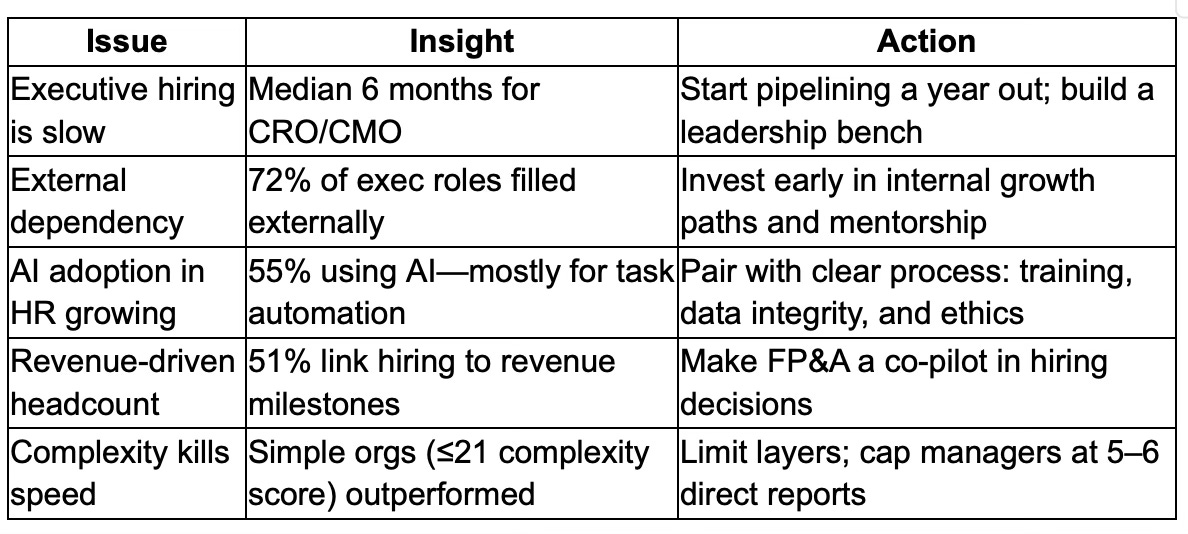Launching a startup provides the initial lift—idea, capital, traction—but reaching escape velocity requires discipline. This next phase, called startup propulsion, is about turning early momentum into sustained growth. Based on recent research and proven tactics, the playbook focuses on five levers strategies to maintain momentum without burnout:
First Achieve Product-Market Fit, Then Scale. One of the most common traps for early-stage startups is scaling too fast, too soon. Headcount growth is often glamorized under the “own the market” mantra, sometimes encouraged by VCs. But the data tells a different story. A 2024 Strategic Management Journal study tracking 38,000 U.S. startups found that those who ramped up hiring before validating their model were far more likely to fail—especially platform startups.
The takeaway: tie each hire to clear, validated metrics—activation rate, conversions, sales cycle length, etc.—instead of building out the org chart prematurely. Growth should follow signal, not noise.
Hire for Altitude, Not Just Headcount. Once PMF is in sight, your hiring strategy becomes a key lever. A recent Lightspeed Venture Partners survey of 127 venture-backed startups offers five insights worth internalizing:
In today’s environment, many founders are opting for fractional execs (CFOs, CISOs) or outcome-based pods rather than locking into full-time roles too early.
Engineer a “Propulsion-Ready” Org Structure. Scaling startups need a structure that supports velocity without introducing drag. That means:
Staying flat in the early phases—ideally one layer between the CEO and individual contributors up to 30–40 employees.
Building with pods—cross-functional units (PM, engineering, design, GTM) that scale independently and preserve agility.
Centralizing critical infrastructure—like data governance and AI centers of excellence—while federating execution to business units. McKinsey’s 2025 survey found this hybrid approach correlated with significantly higher EBIT uplift compared to extreme.
Use AI as a Startup Afterburner. AI’s real power lies not in scattered pilots, but in end-to-end workflow redesign. McKinsey reports that only 21% of companies have taken this step—but those that did achieved the greatest performance improvements. Governance also matters when CEOs and CFOs took ownership of AI strategy, EBIT impact was highest.
For startups, this means weaving AI into the fabric of daily operations—from LLM-powered ticket triage in customer success, to code-completion in engineering, to AI-assisted lead gen and content workflows in marketing, to proposal support and pricing analysis in sales. Used strategically, AI isn’t just a tool—it’s a multiplier of GTM execution, efficiency, and company culture.
Additional Tactics to Sustain Momentum. Even with the right people and structure, sustaining growth comes down to operational discipline. A few tactical levers:
Outsource smartly to “rent” dev or Tier-1 support capacity during peak periods without long-term cost.
Bring in fractional advisors—1–2 days/month from experienced leaders can elevate execution until the full-time need is clear.
Link every growth bet to revenue outcomes via OKRs or KPIs. Regularly revisit these with finance to guide hiring and spending.
Instrument early and often. Lightweight data pipelines (e.g., PostHog + dbt) can surface real-time signals around PMF and unit economics—before you drift off-course.
Collectively, these measures help startups move with speed and precision—an essential combination when the margin for error is razor-thin
Conclusion: From Lift-Off to Lasting Traction
Initial momentum can get you airborne, but long-term success demands more than energy—it requires grit, deliberate systems, and smart execution. Startups that endure don’t just scale quickly; they scale intentionally. By aligning hiring with outcomes, structuring for adaptability, embedding AI deeply, and tracking progress with clarity, founders give themselves the best shot at building something not just explosive—but enduring. Startup propulsion isn’t about burning brighter. It’s about flying farther.
Share this blog post: If you know a founder or startup CEO who's navigating the challenge of turning early traction into lasting growth — it might be just what they need.





